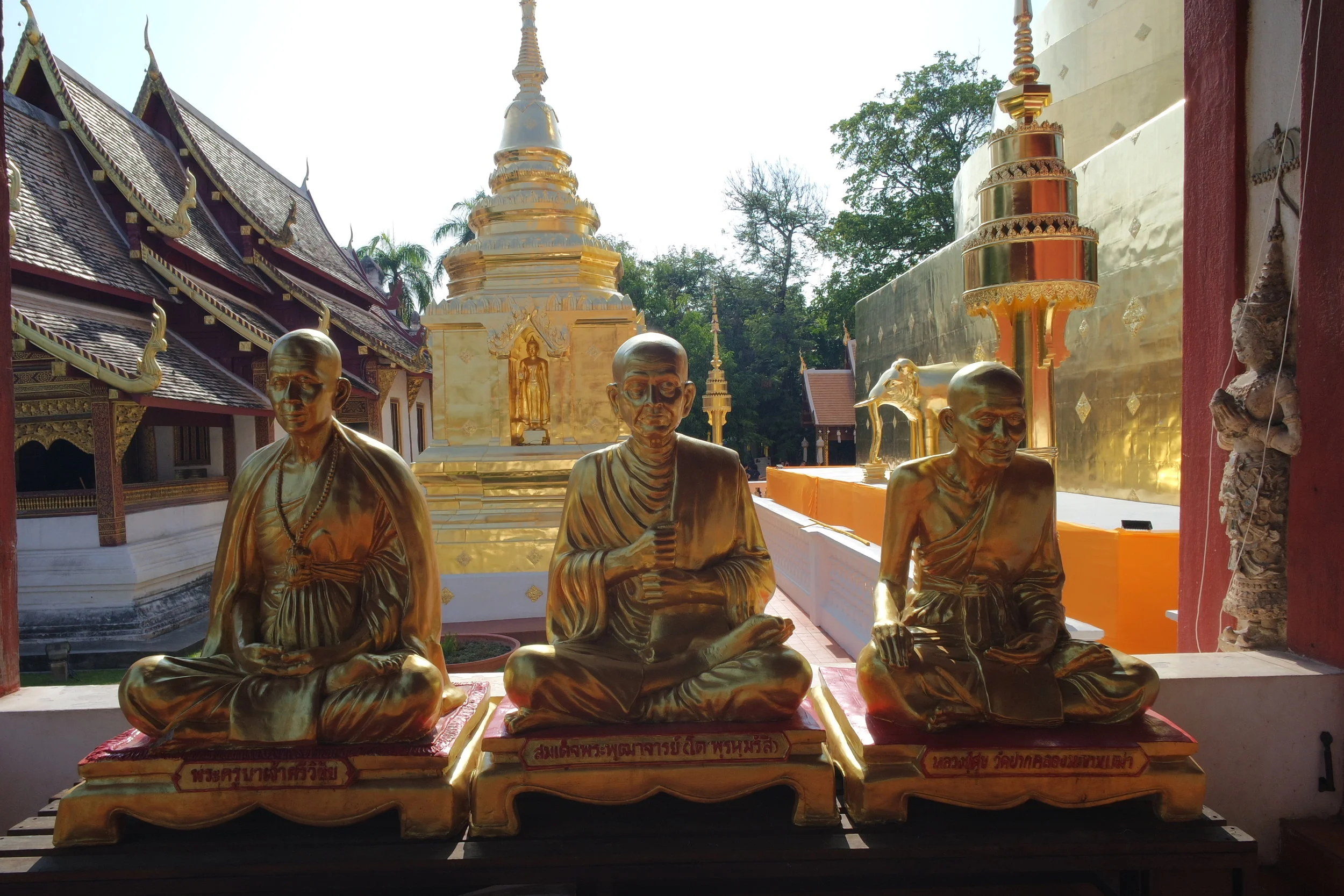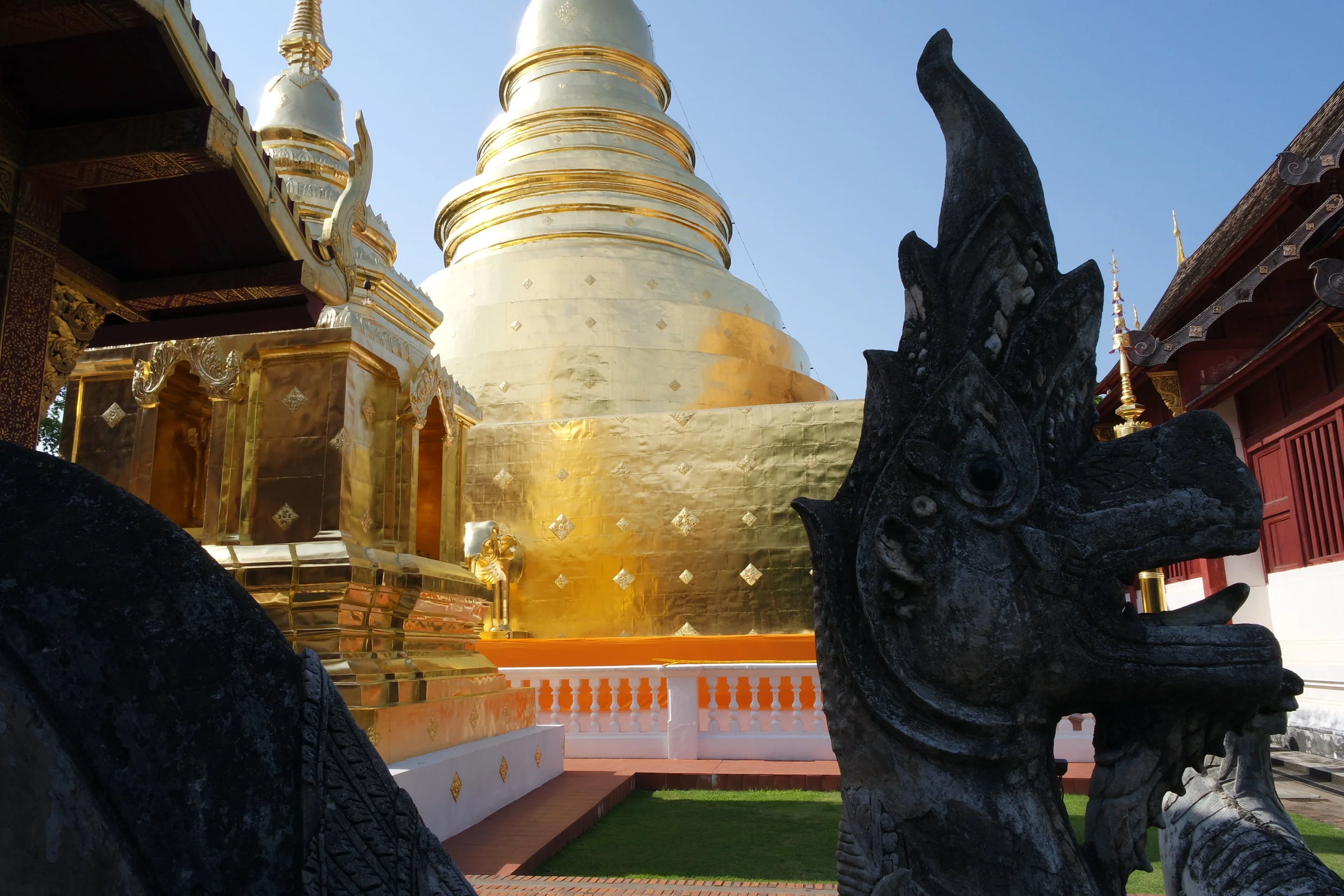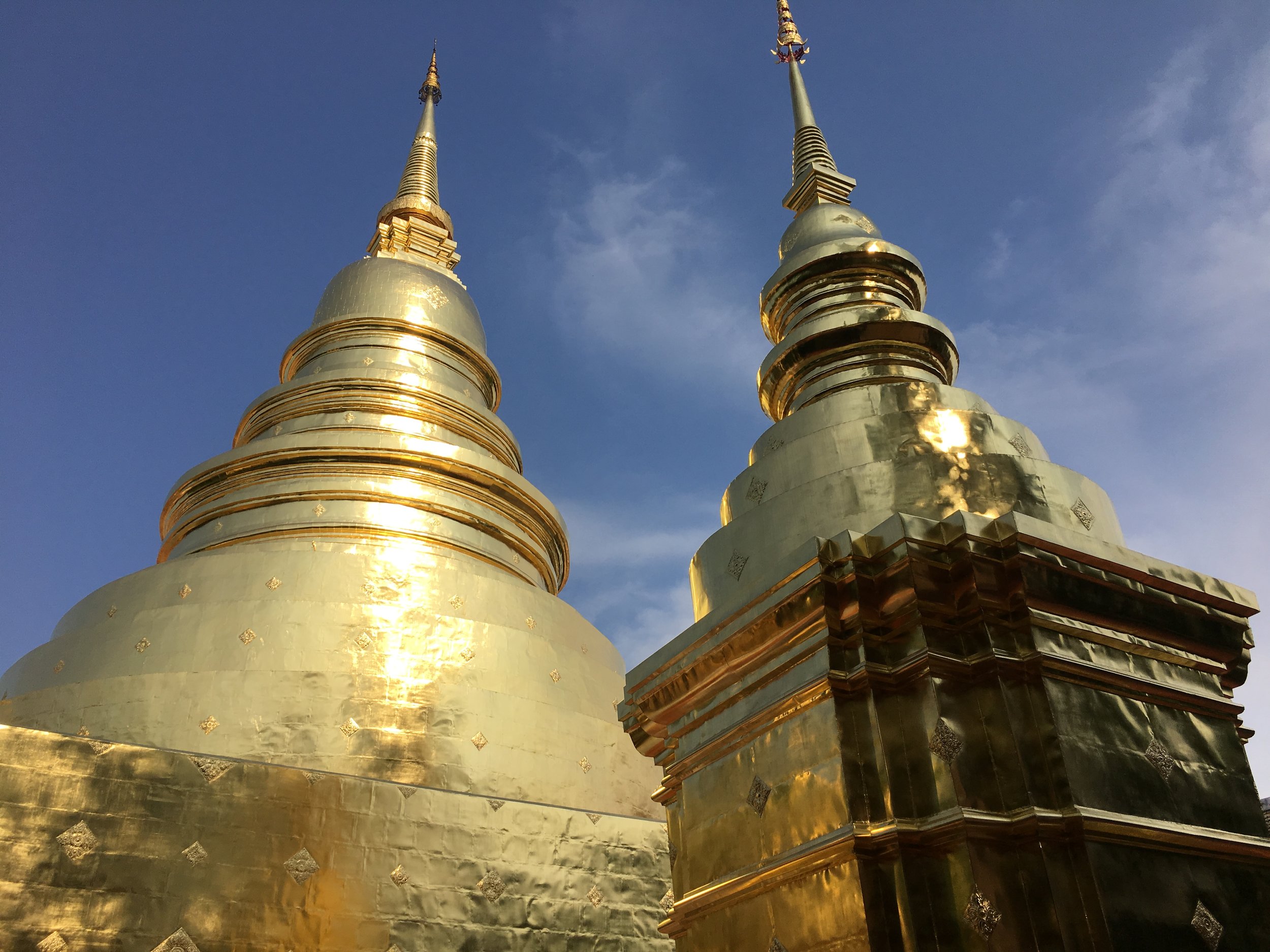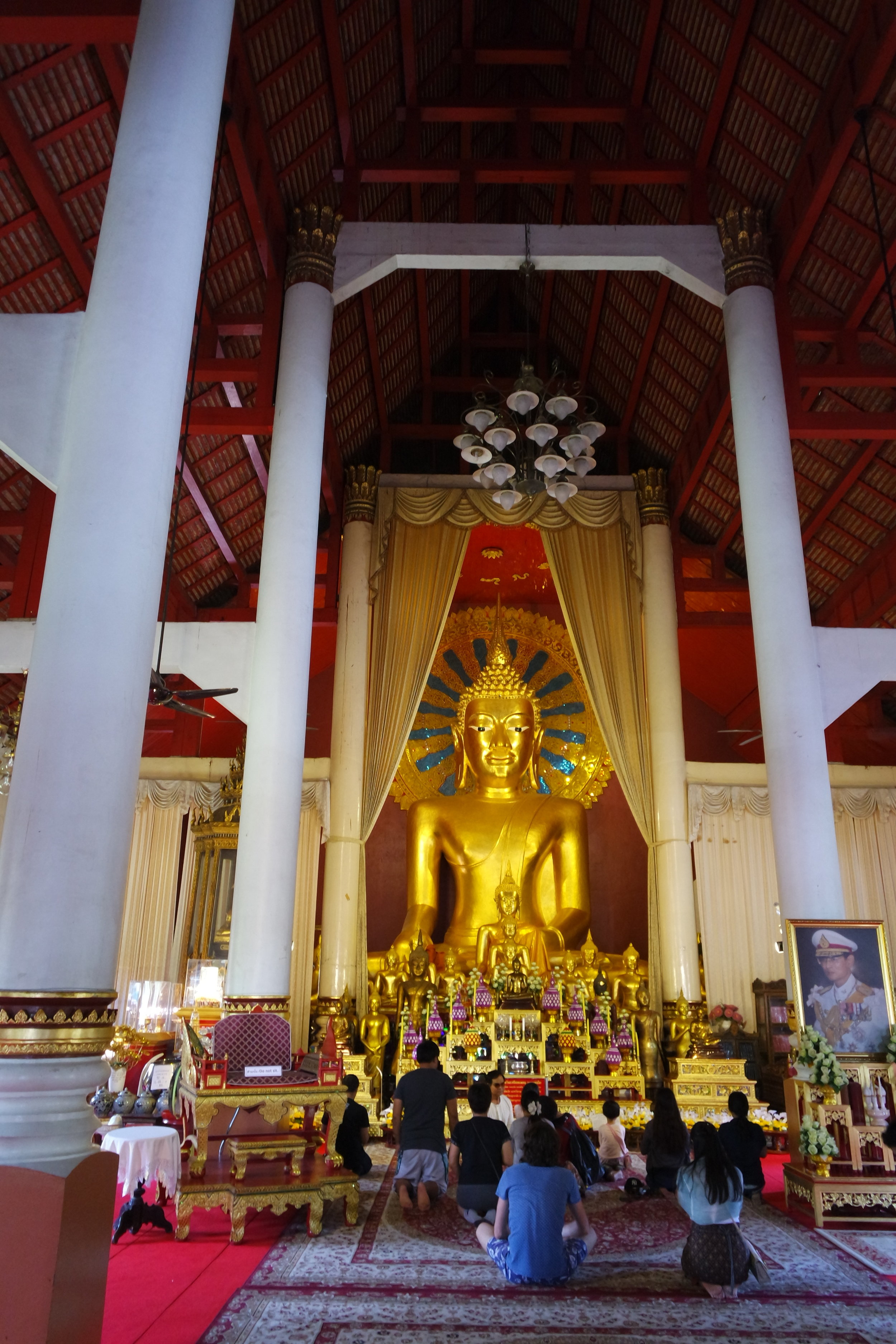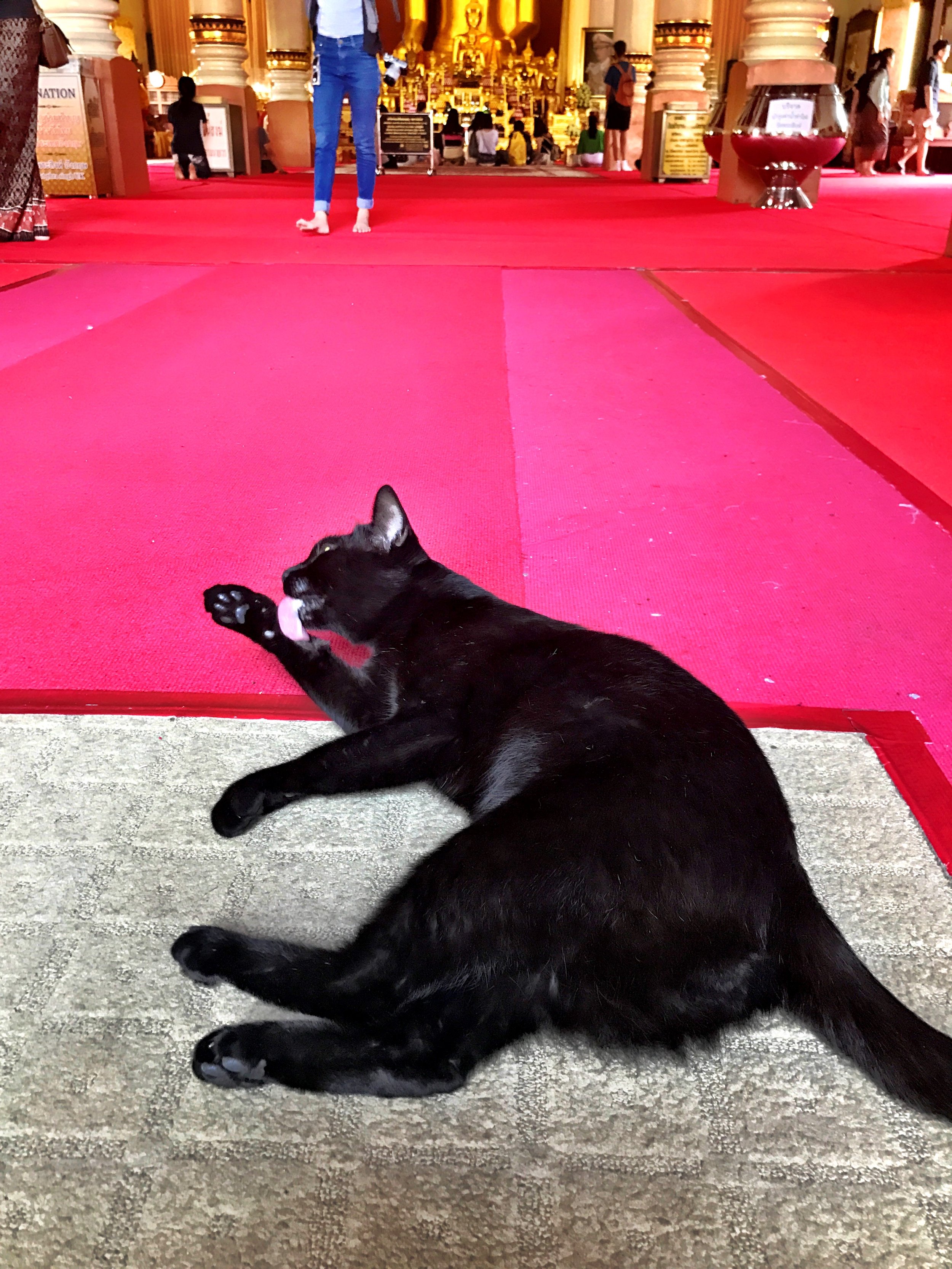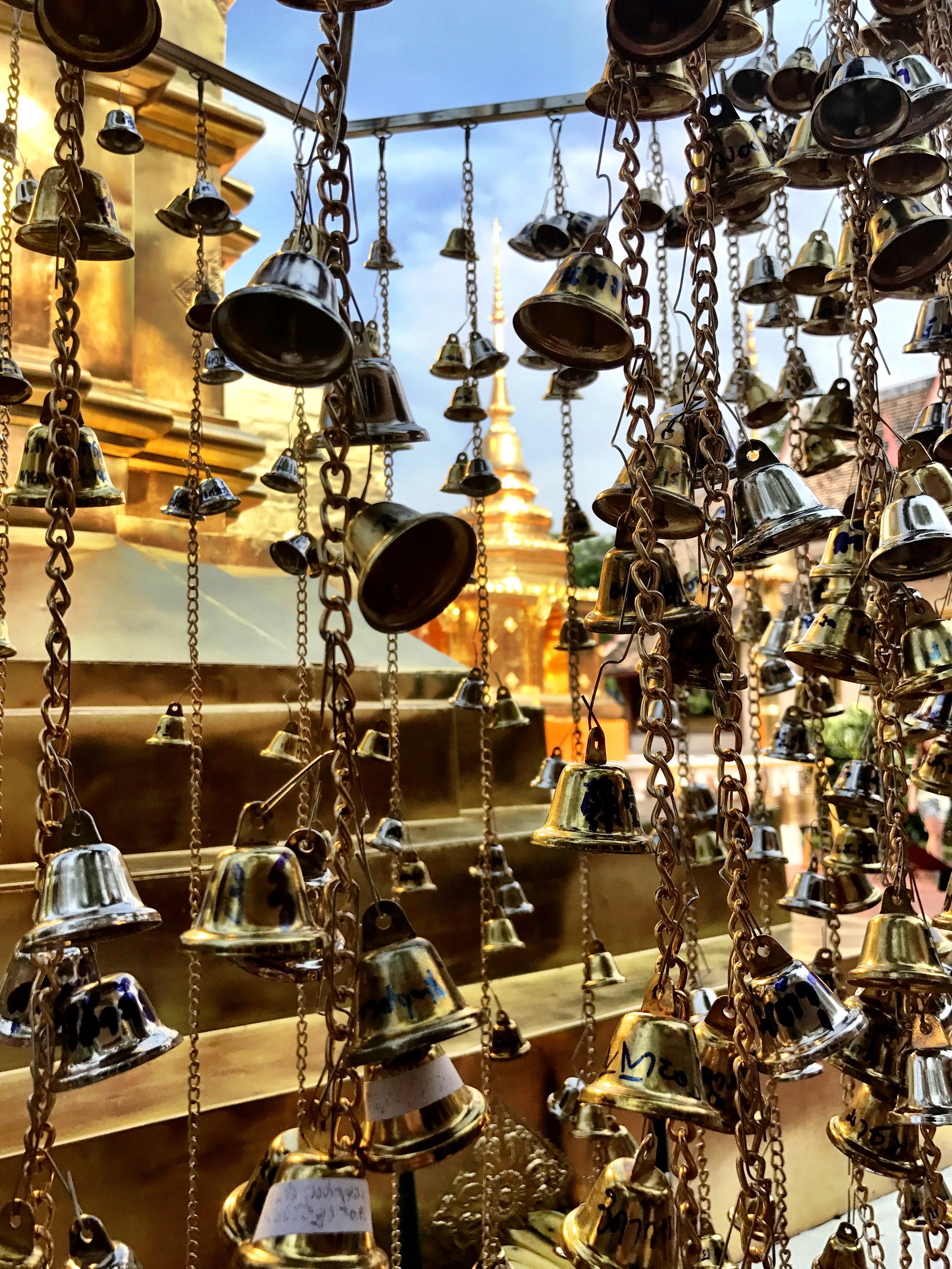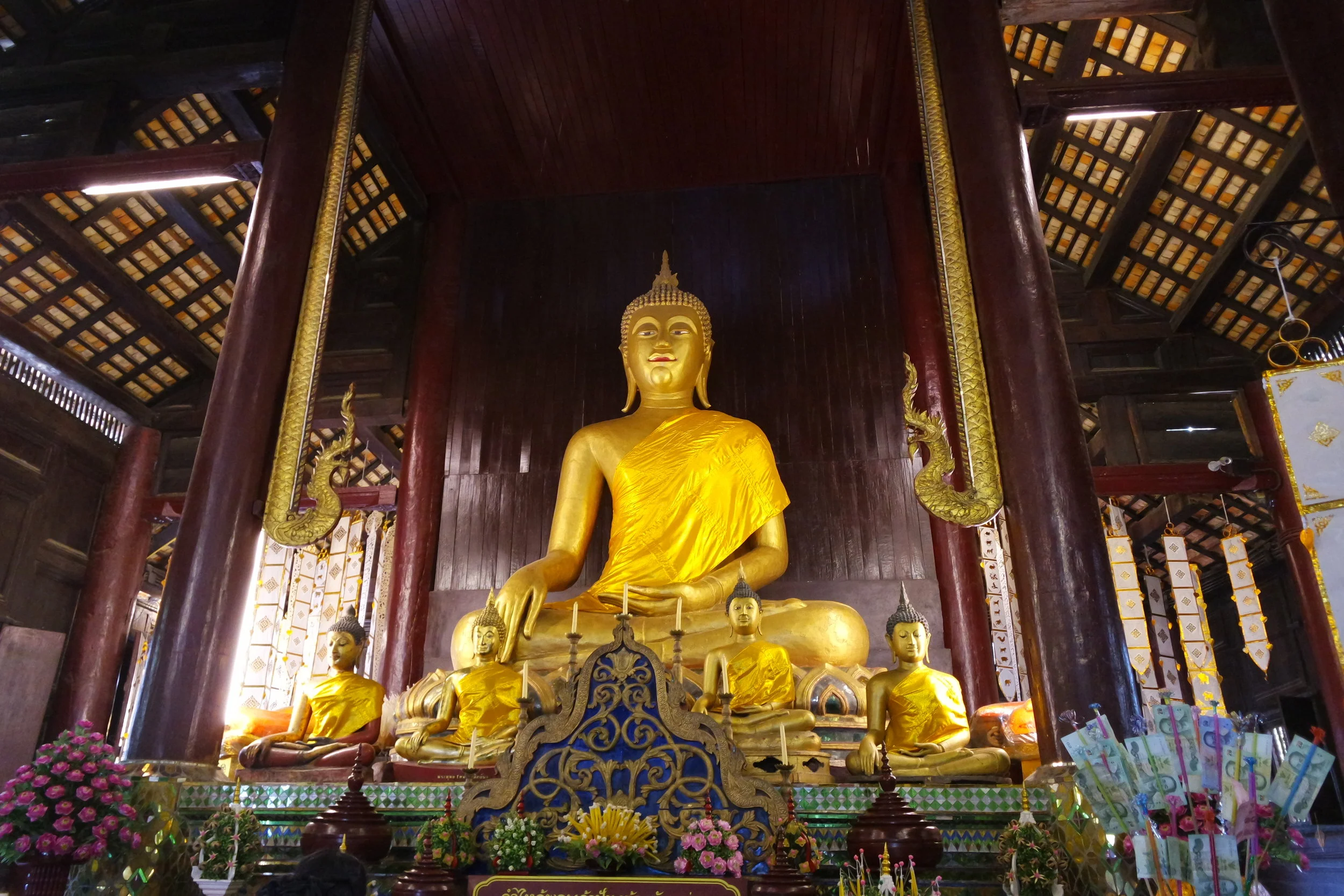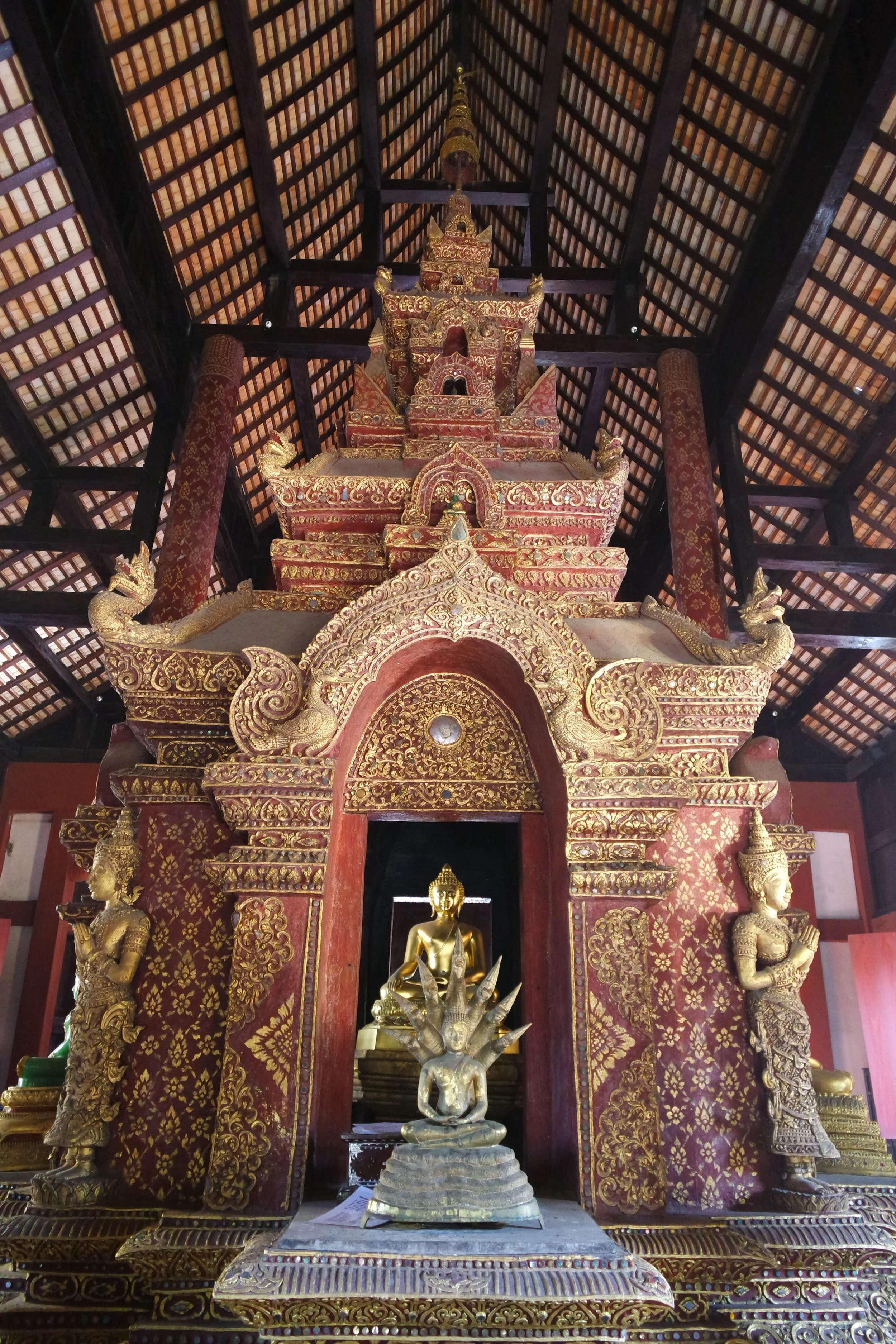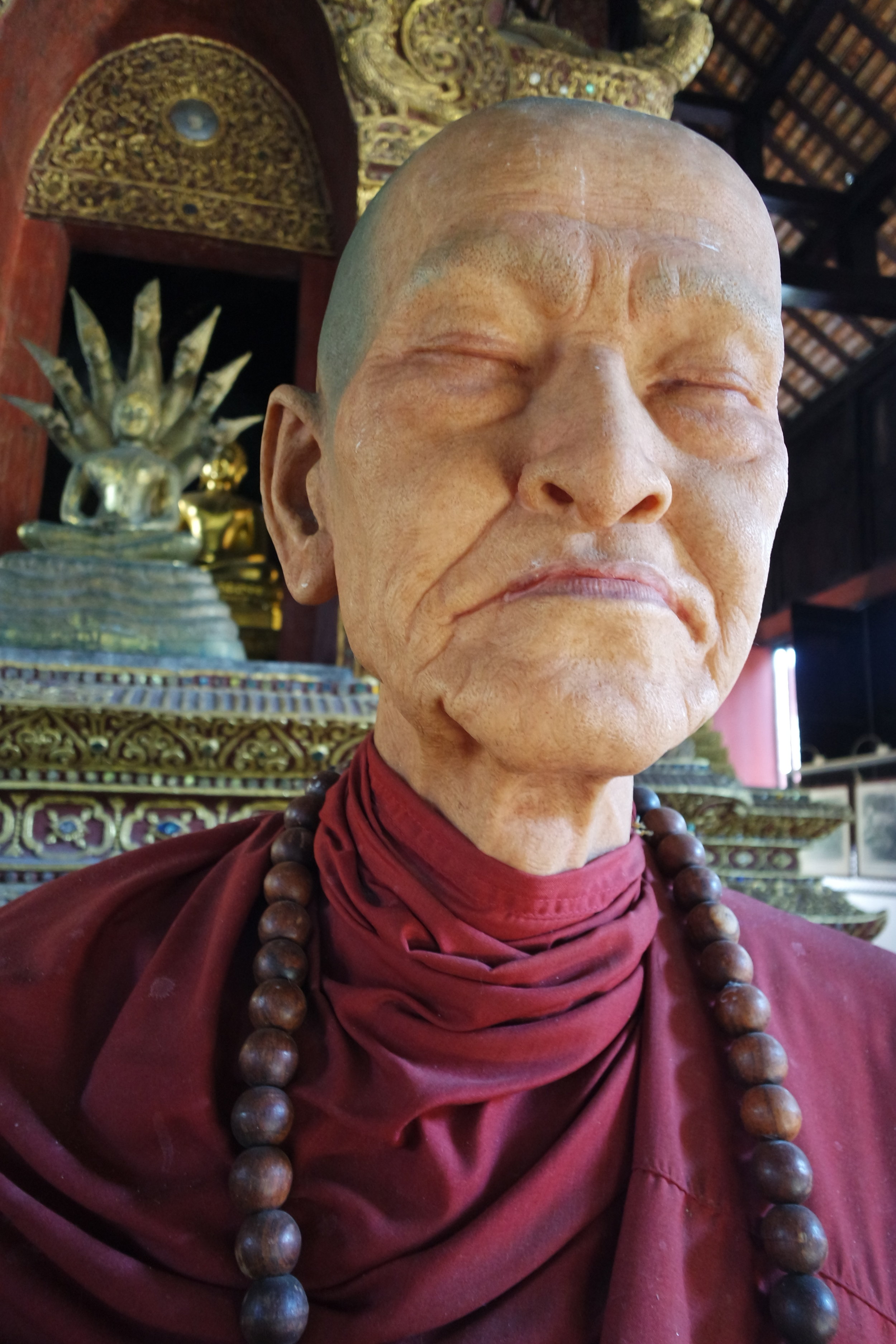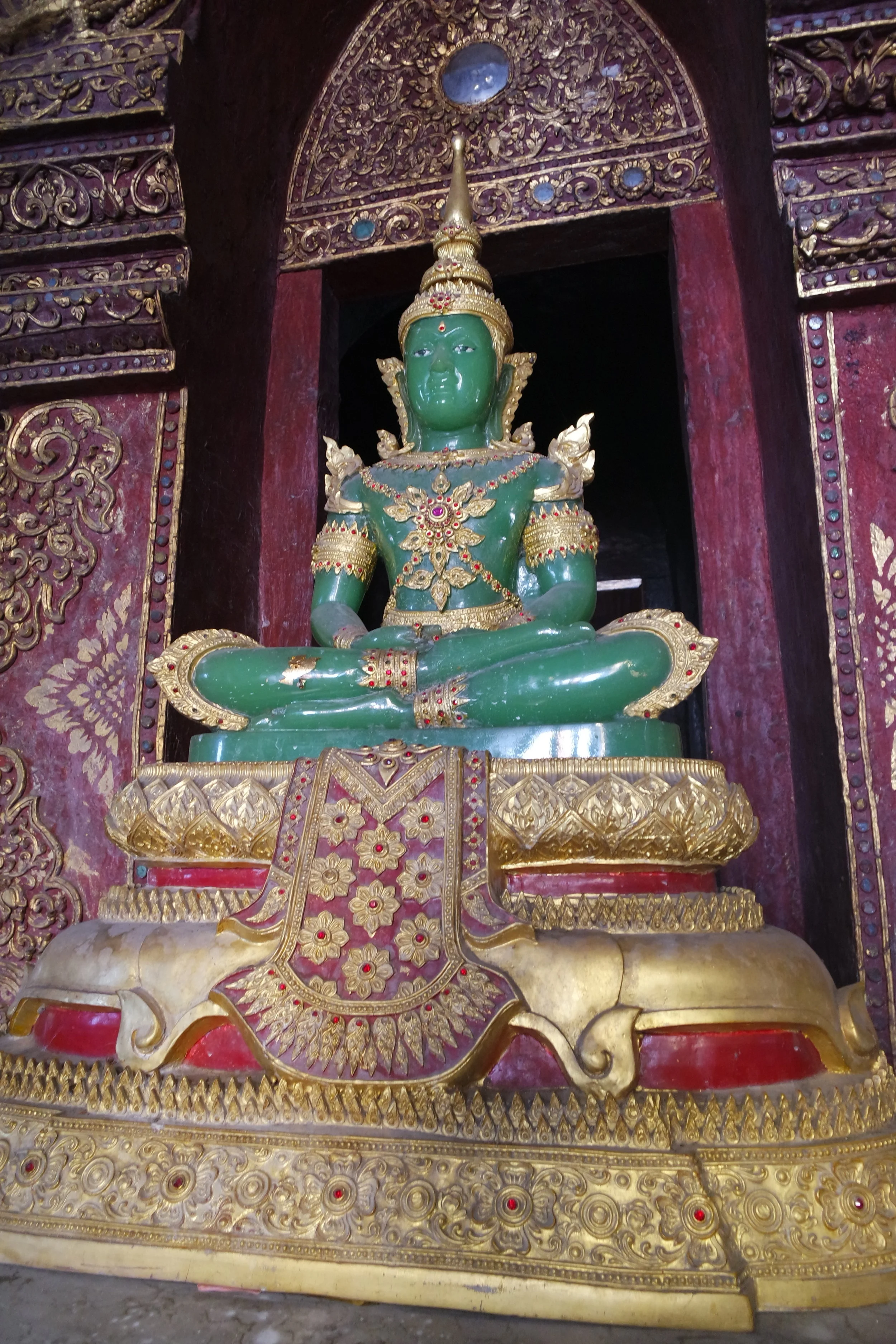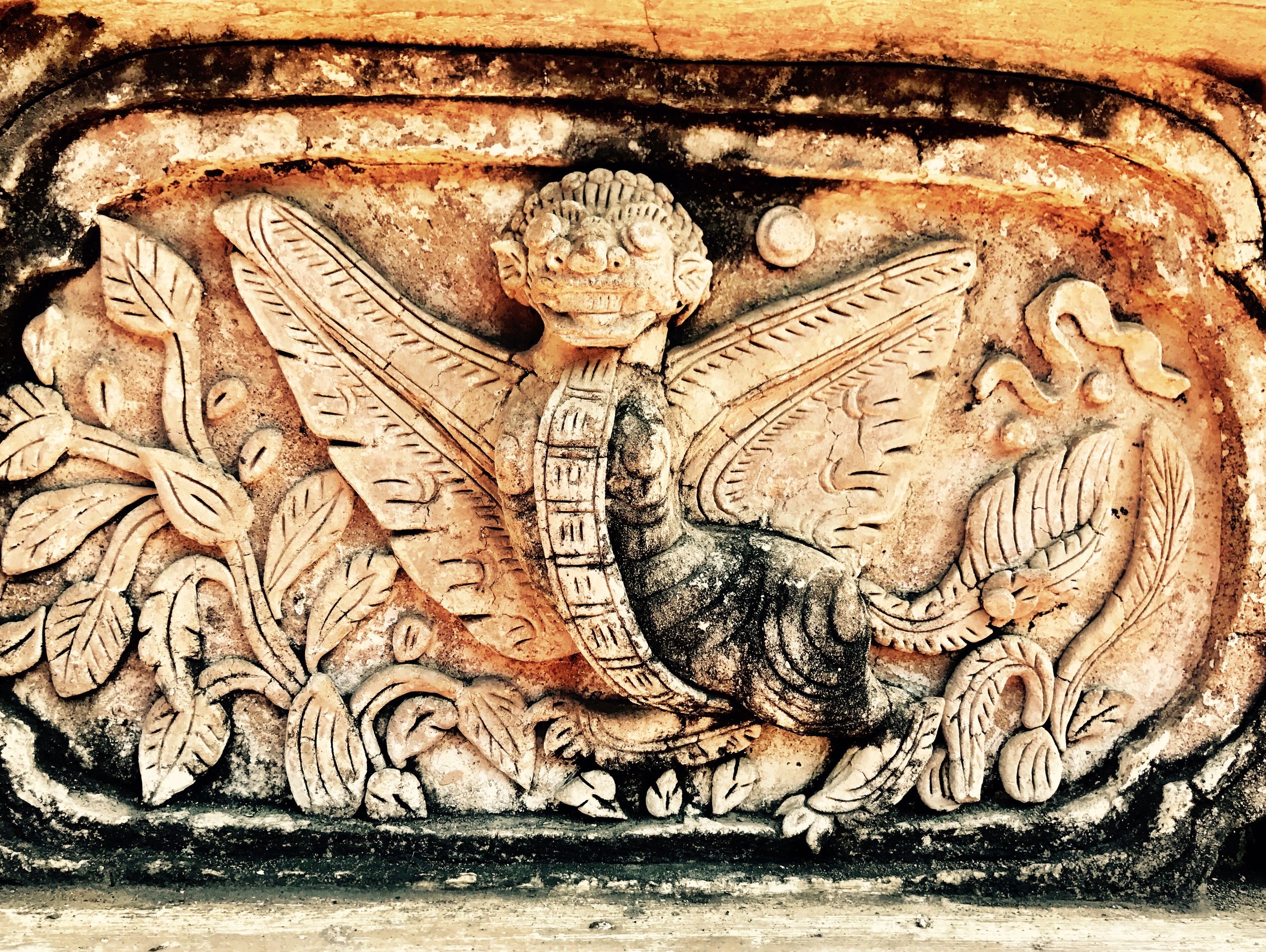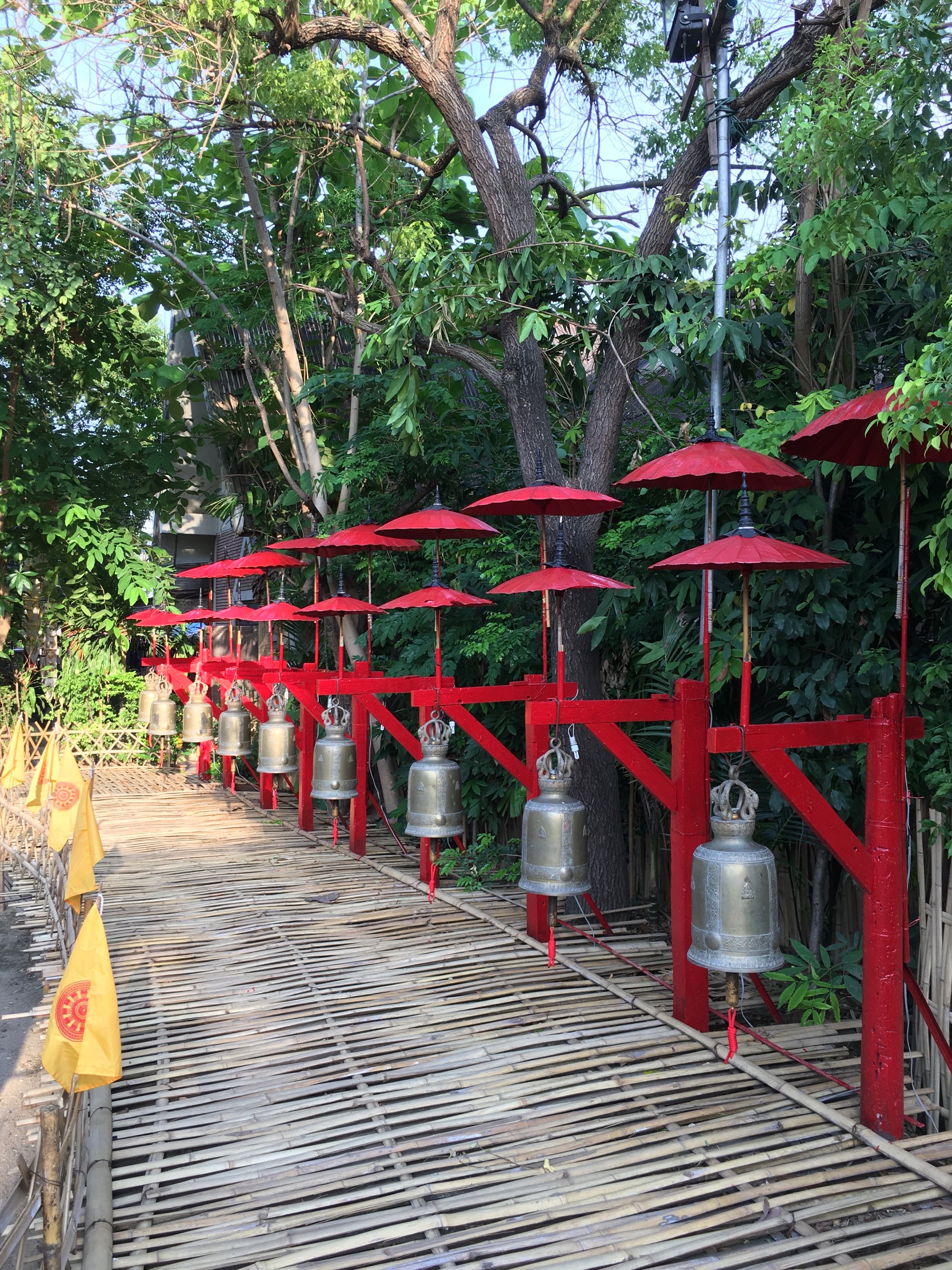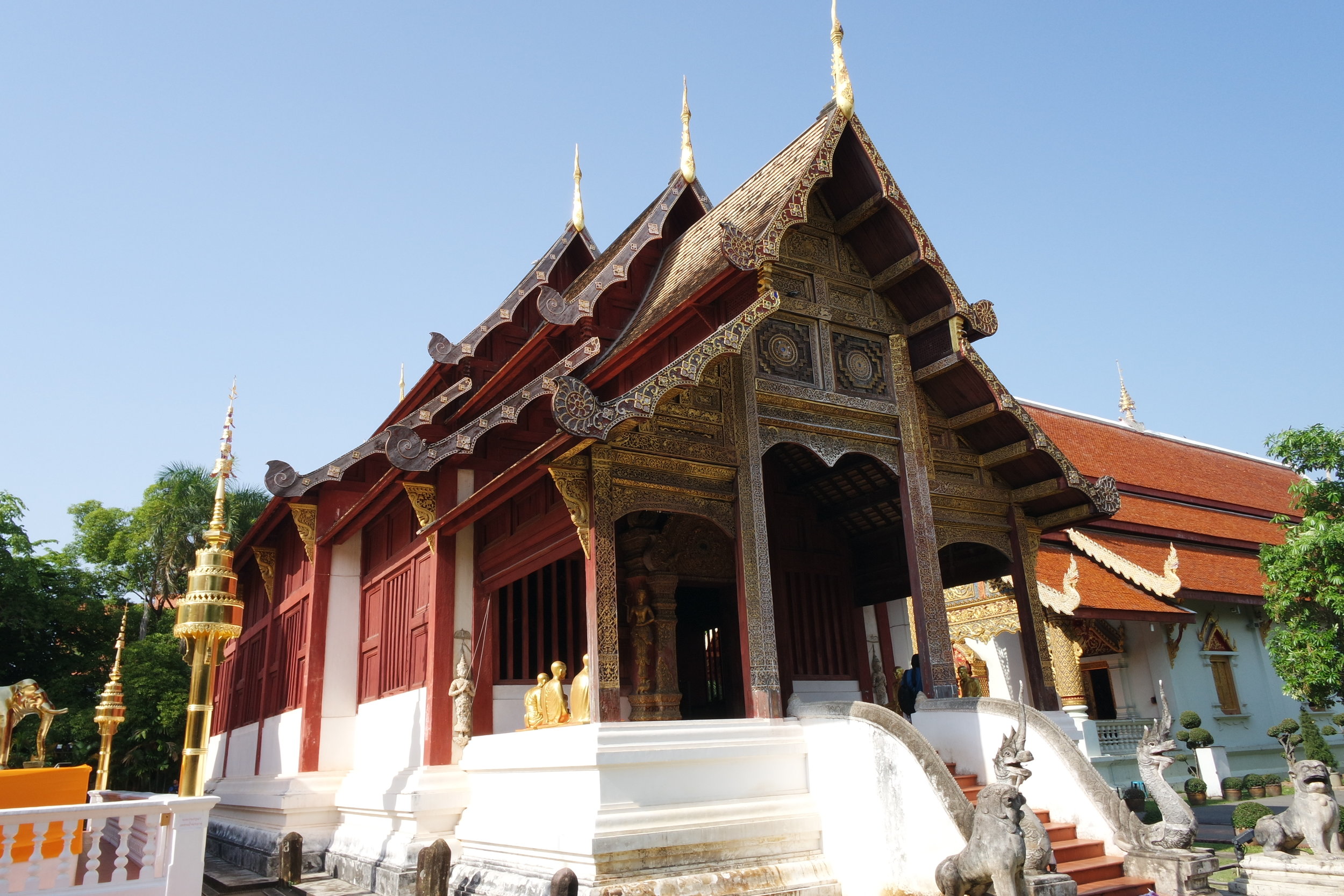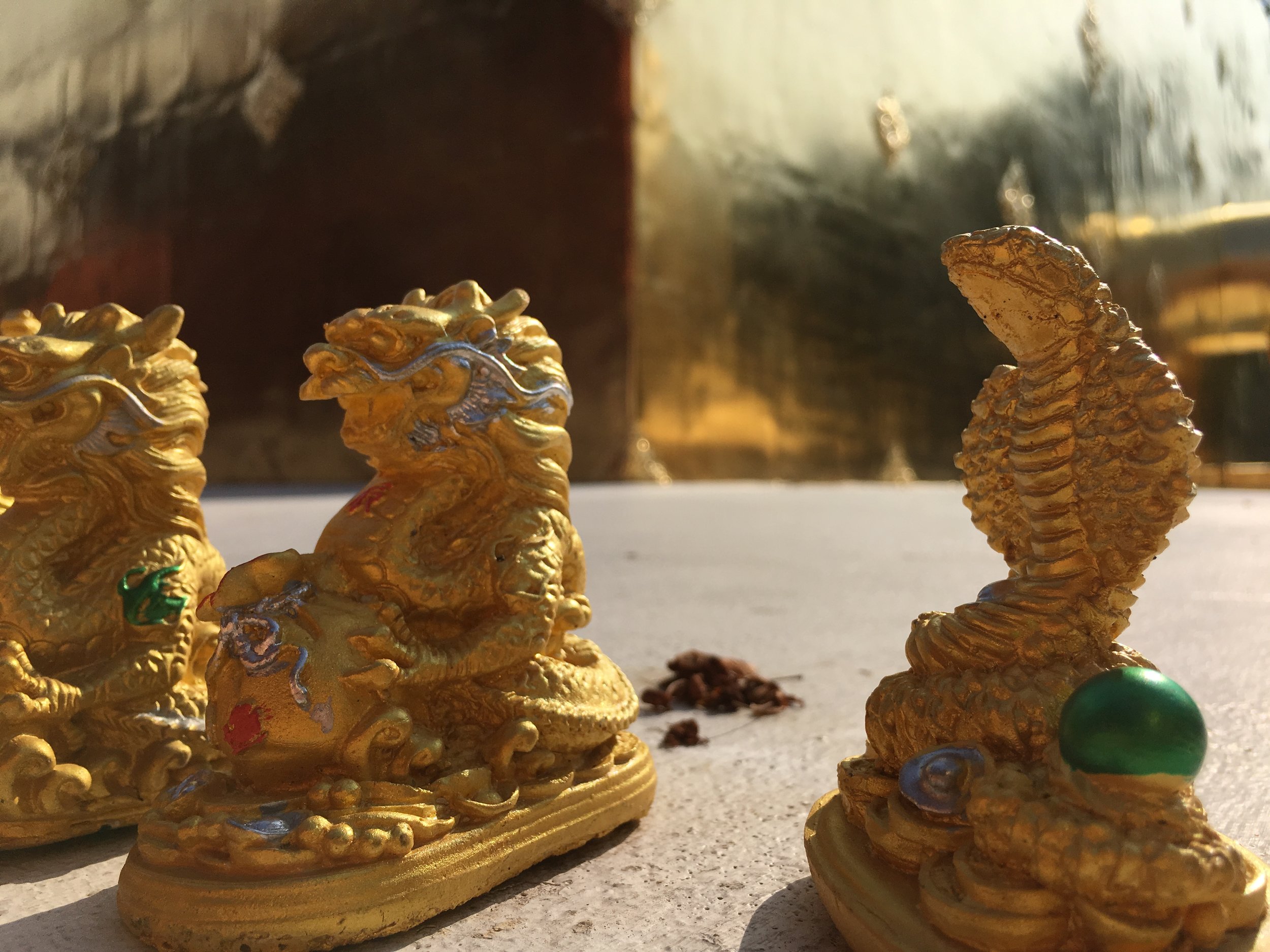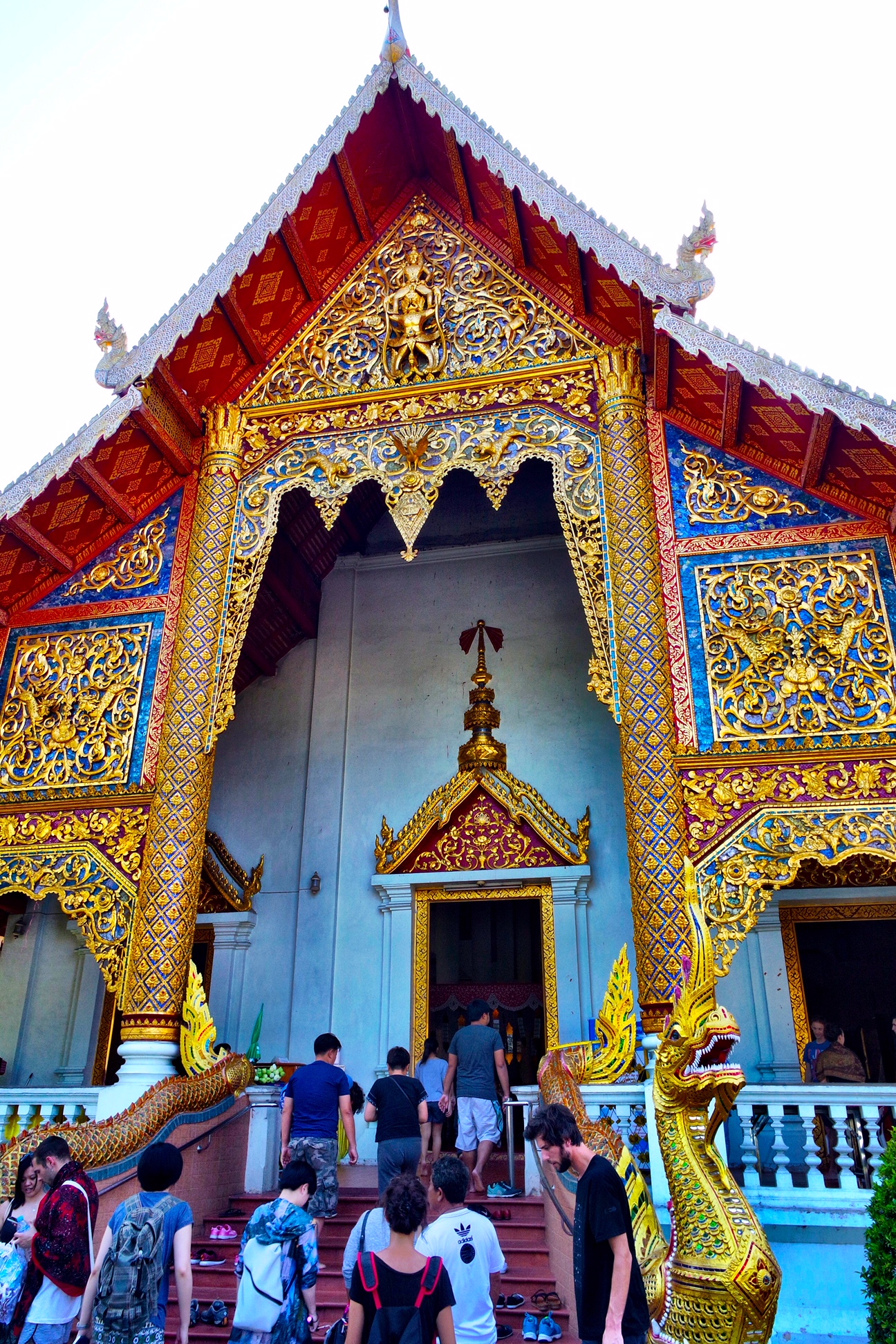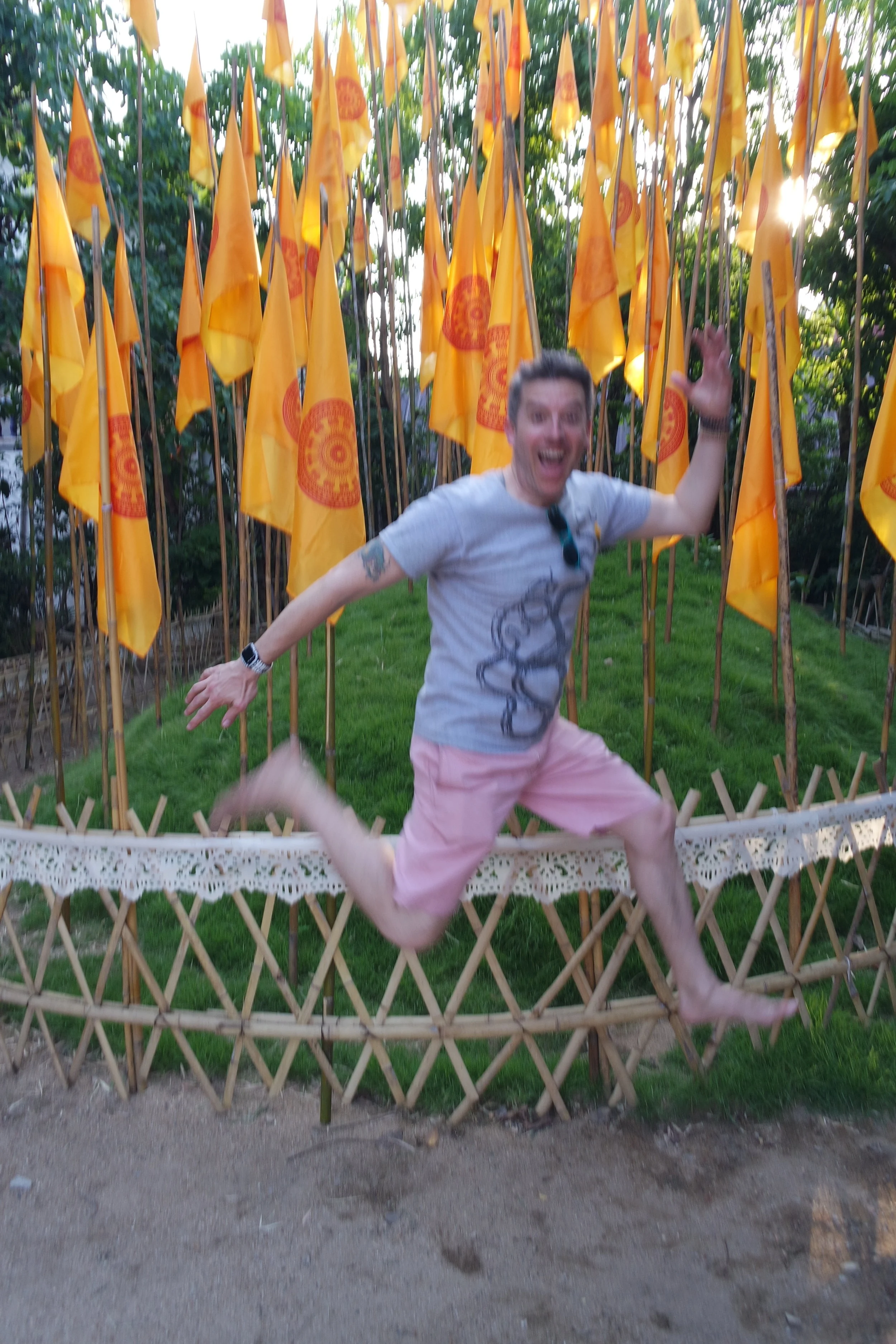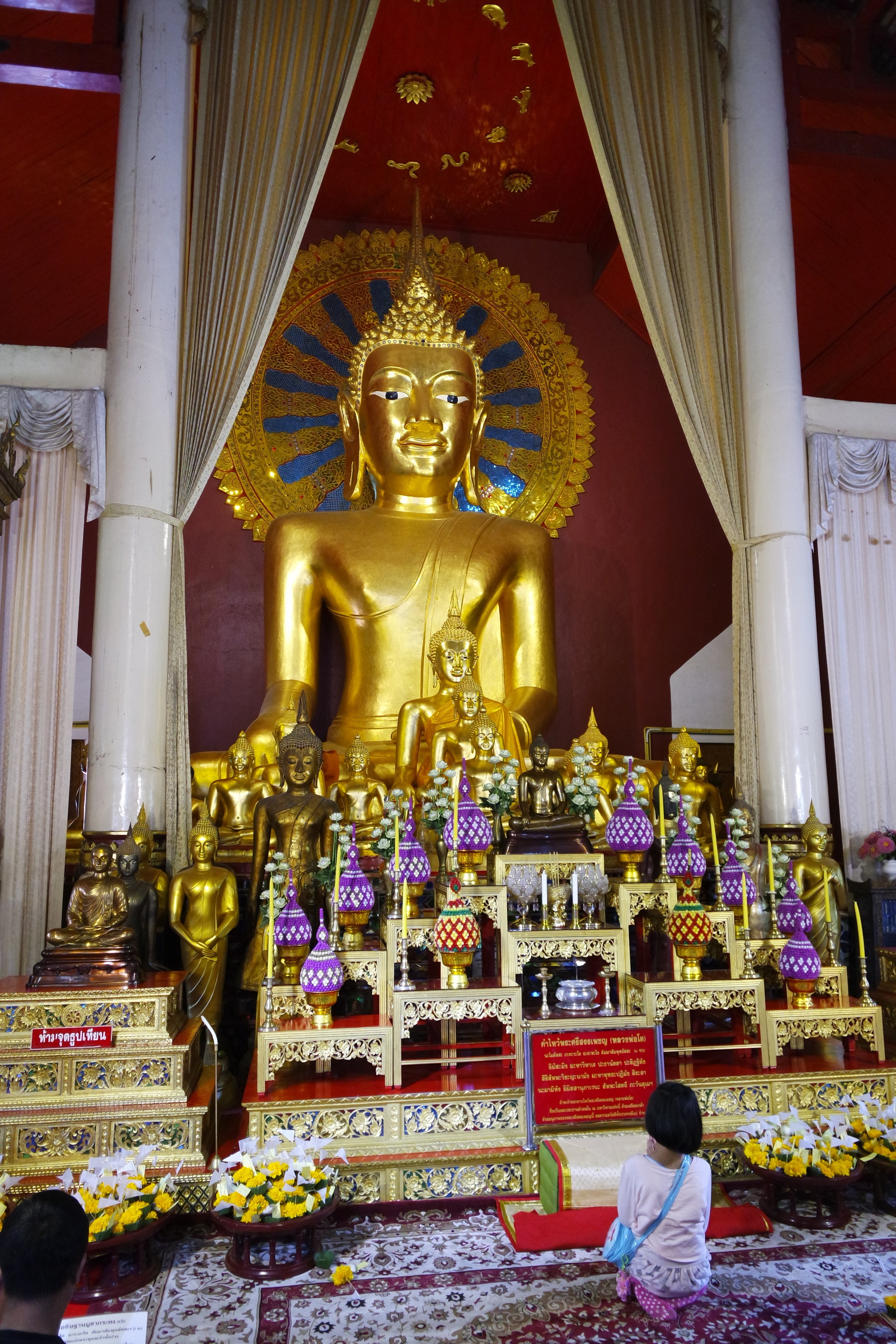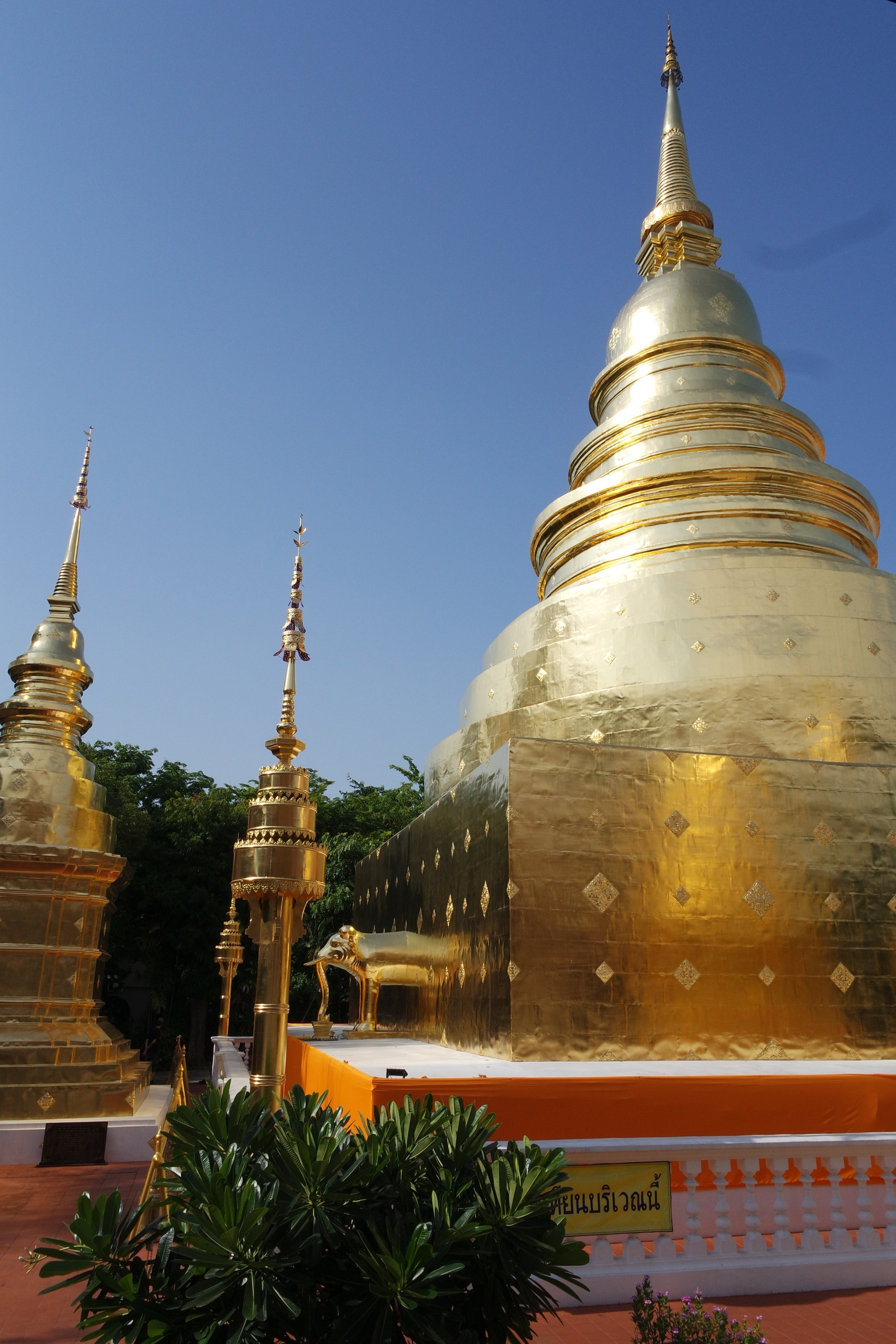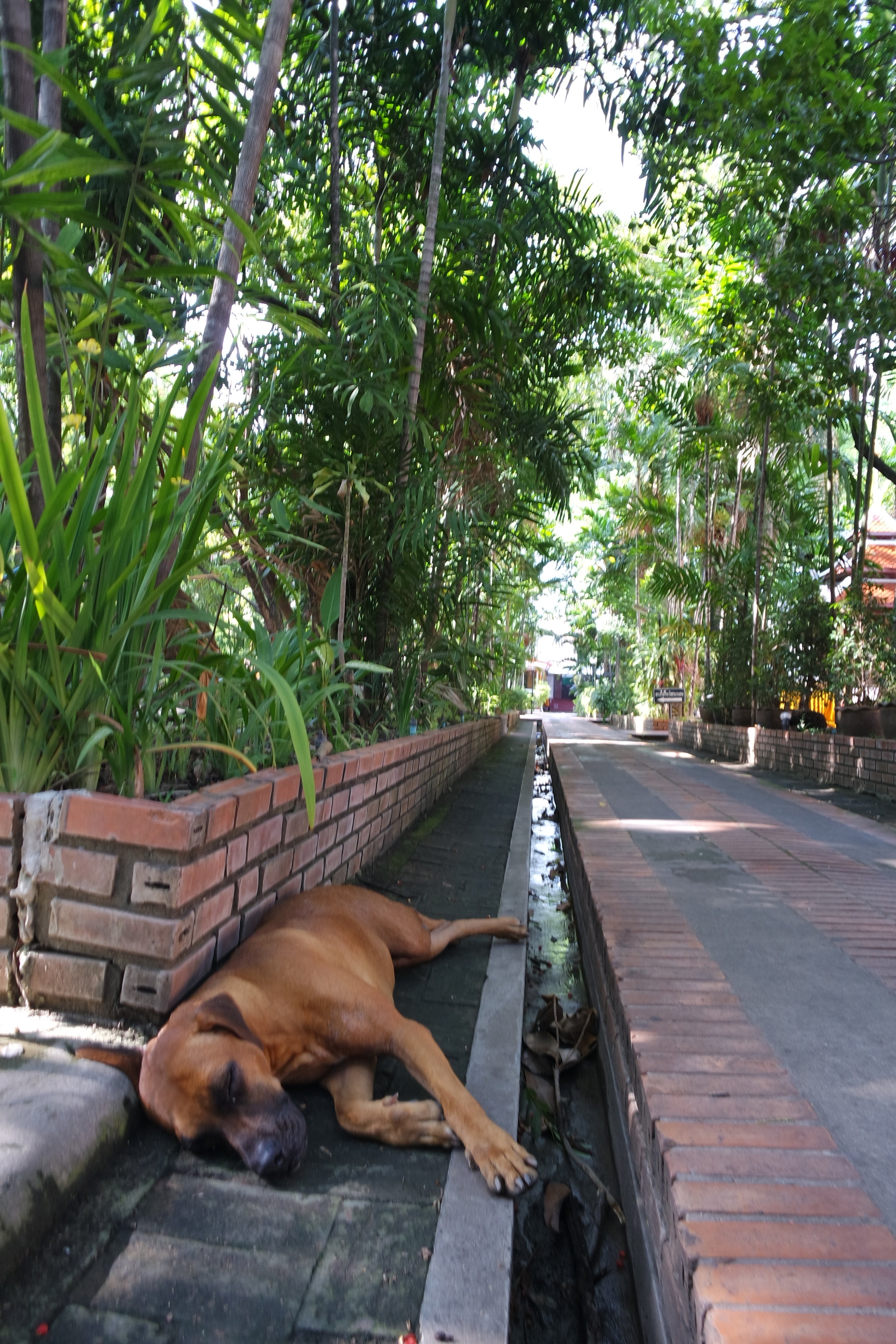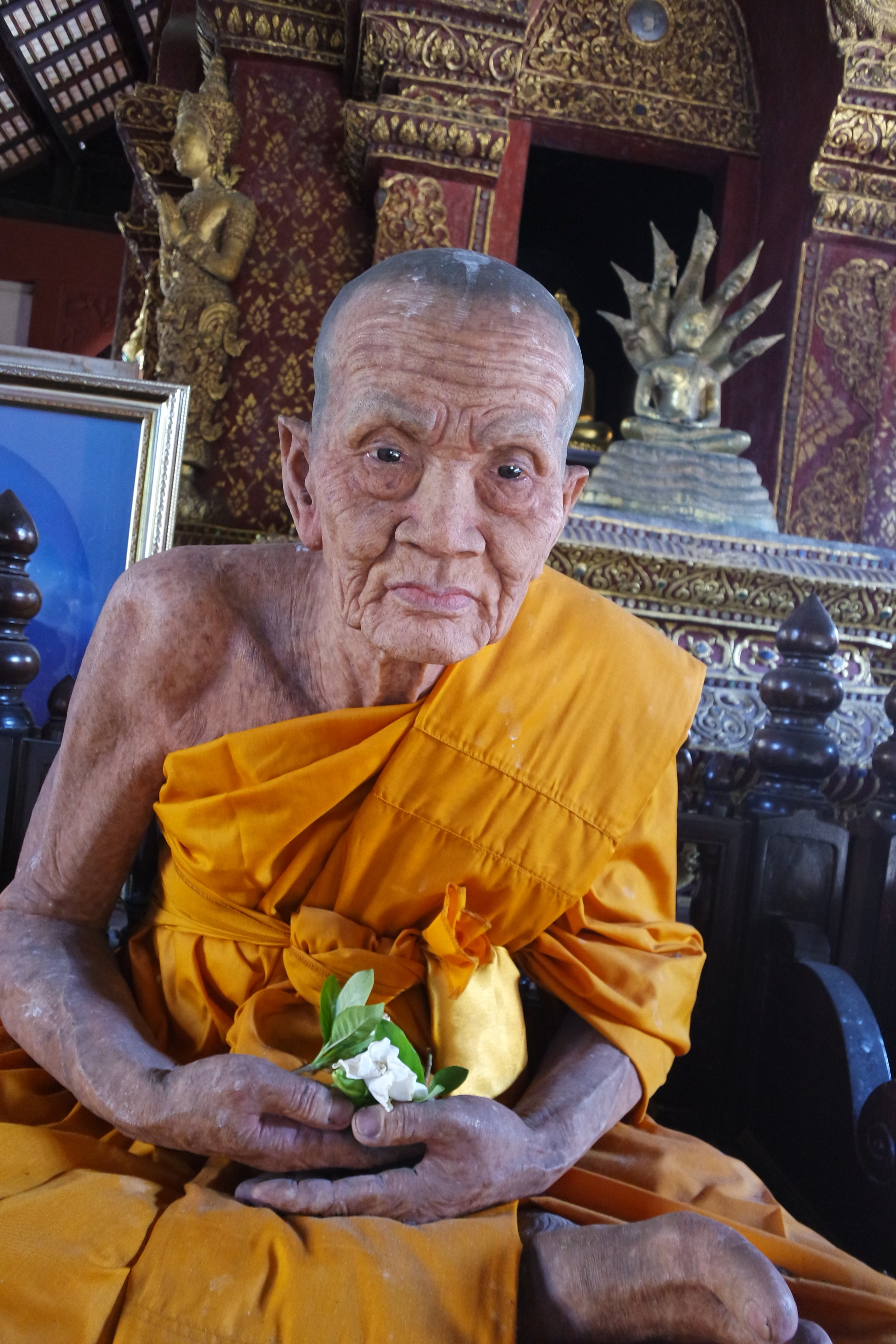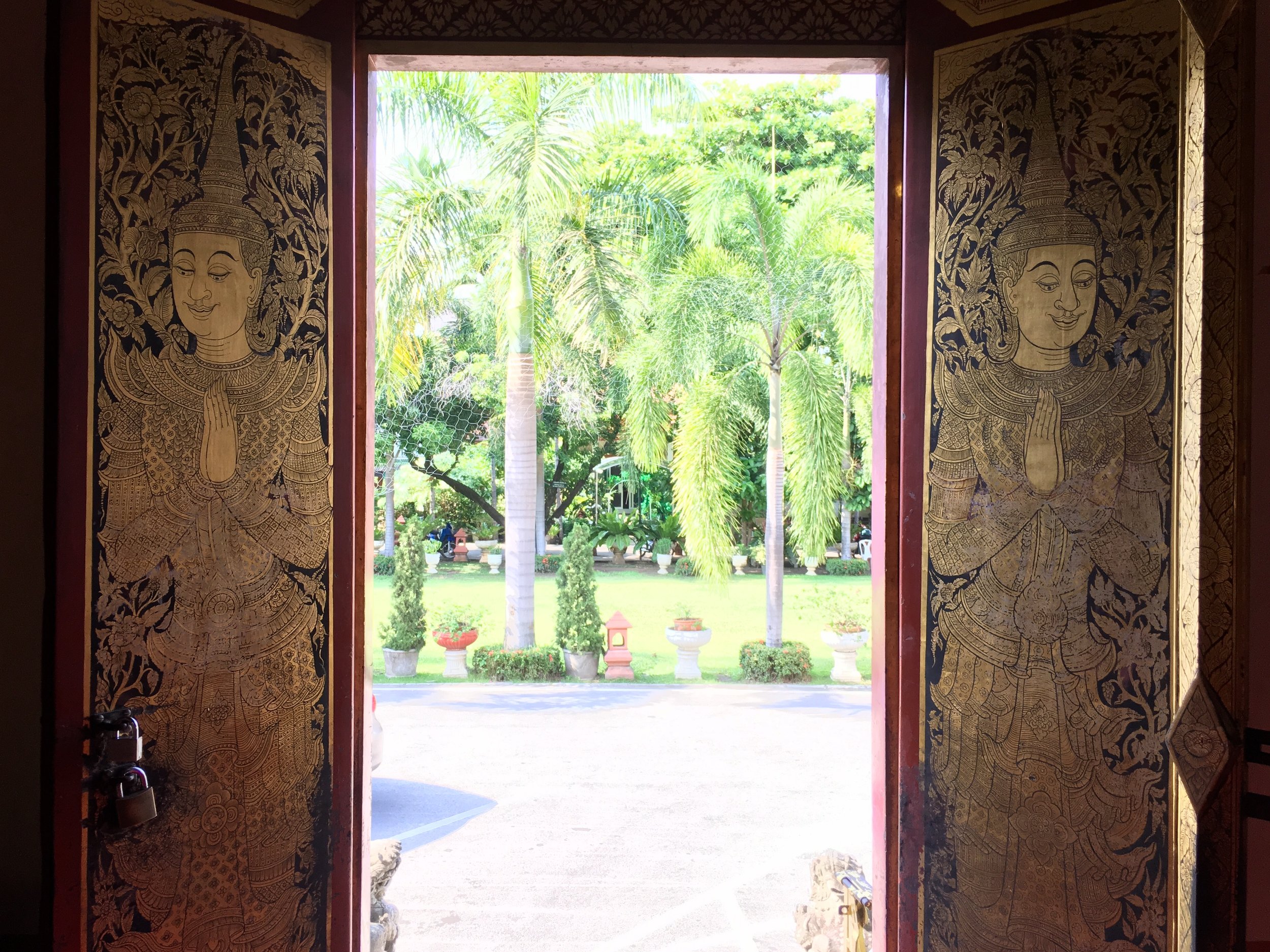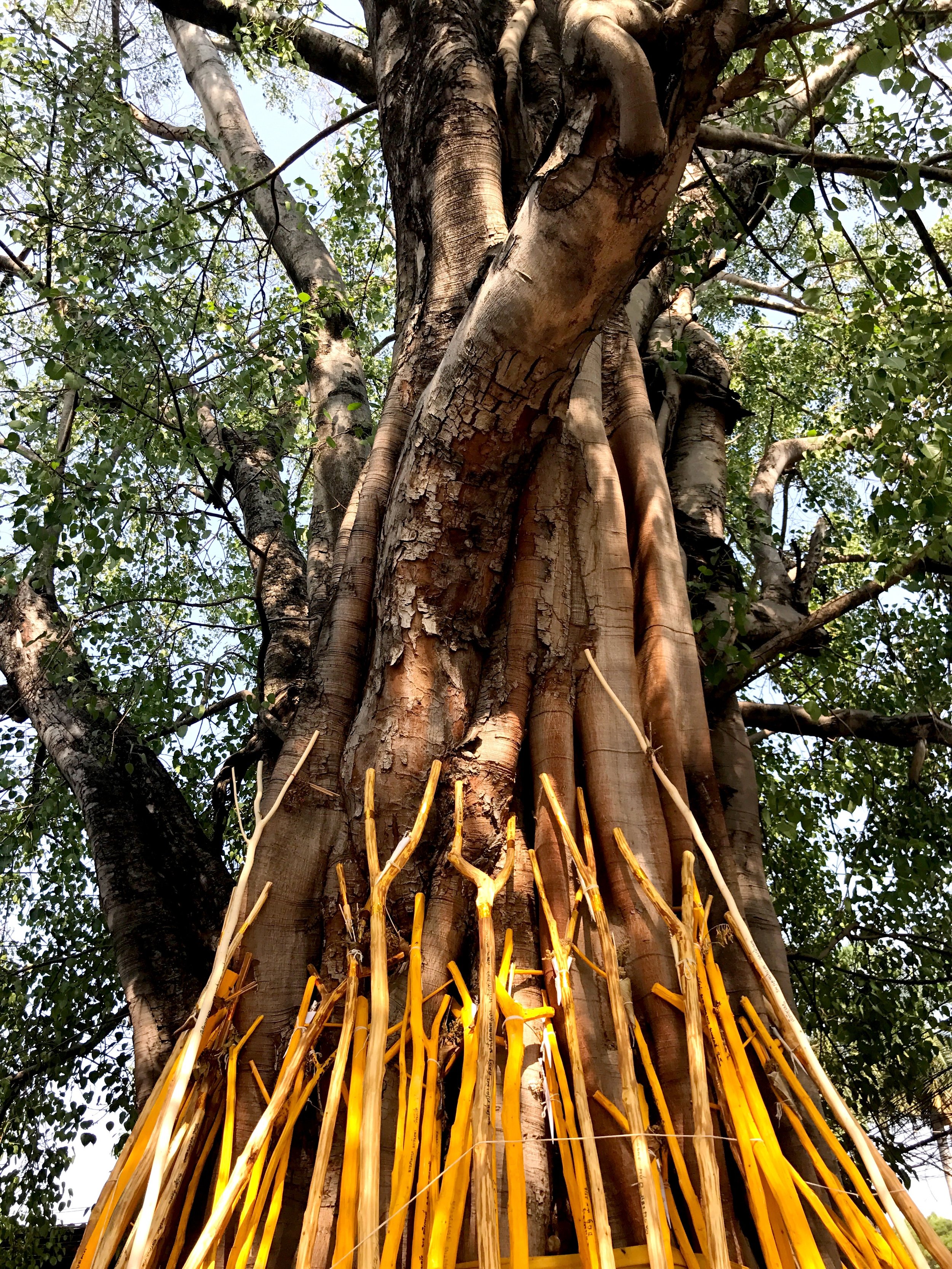One of the best examples of Lanna architecture, the Lion Buddha Temple features golden chedi, gorgeously decorated buildings and some hellish murals.
Wat Phra Singh is held up as one of the best examples of Lanna architecture
Wat Phra Singh is one of the most popular tourist attractions in Chiang Mai. And while it’s an impressive temple — that’s a short walk to Wat Chedi Luang, another spot travelers always hit — Duke and I sometimes prefer exploring some of the more off-the-beaten-path wats.
The temple is one of the most popular stops for tourists staying in Chiang Mai
That being said, travelers should definitely add Wat Phra Singh to their itinerary. Parts of the wat, which translates to the Lion Buddha Temple, were built in the mid-1300s and renovated in the early 1800s.
There’s no shortage of glittering gold on many Thai temples — and Wat Phra Singh is no exception
The temple complex’s buildings are gorgeously gilded, with their telltale Lanna-style rooftops, layered like feathers on wings about to spread and soar into the heavens. In fact, Wat Phra Singh is held up as one of the finest examples of Lanna architecture.
The famous Lion Buddha, the star of the Thai New Year parade/water fight, lost its original head
Viharn Lai Kham: Marvelous Murals and the Headless Lion Buddha
At the back of the walled-in compound is the Viharn Lai Kham (the Gilded Hall), an assembly hall that features fading murals from the 1820s. The paintings depict scenes from the Jataka tales, native to India, which tell of the previous lives of the Buddha. Another source says the murals show local ways of life. To be honest, it was hard to make much out.
This is where the namesake Lion Buddha, a treasure from the 14th century, is housed. Local lore says the statue came from Sri Lanka, though some historians say it looks suspiciously as if it was made locally. (There’s no direct connection to a lion, leading some to posit that the Singh in its name is actually a corruption of Sri Lanka.) In 1922 someone dared to steal the head right off the Lion Buddha! Talk about bad karma!
During the Thai New Year festival, Songkran, the Lion Buddha is carried through Chiang Mai, and people splash water on it for good luck.
The beautiful doors at the Viharn Lai Khan hint at what its name translates to: the Gilded Hall
While we admired the interior of the viharn, a couple of Thai students came over and asked if they could interview Duke. From their broken English and Duke’s attempts to speak about the murals without knowing much about them…well, let’s just say I don’t think the documentary will be scoring any prizes at Sundance.
There aren’t any lions on the grounds of Phra Singh that we could see — but you’ll always find plenty of giant snakes called nagas
The pagodas found on Thai temple grounds hold some sort of sacred relic
Elephants sticking out of the golden spire make this a one-of-a-kind chedi in Chiang Mai
Golden Chedi With Elephant Adornments
The oldest structure on site is the main chedi, which was constructed in 1345 by King Pha Yu to enshrine the ashes of his father, King Kham Fu. The golden yellow chedi is blindly bright in the sunlight. Elephants are depicted as emerging from the chedi, the front halves of their bodies poking out of the shiny copper.
While you’re here, maybe say a prayer that you don’t go to Naraka to be tortured
Viharn Luang: A Vision of Heaven and Hell
The largest building on the grounds is the Viharn Luang. The current structure replaced the original in 1925. There’s another highly venerated Buddha image inside. Referred to as Phra Chao Thong Tip, it was cast in gold and copper back in 1477. The Buddha is seated and has his hands gesturing in the Subduing Mara mudra, which calls back to when the demon Mara tried to distract the Buddha as he sat under the bodhi tree, about to reach enlightenment.
A polite worshipper shows that you never point your feet toward an image of the Buddha (though I’m not sure you should take bath in a viharn)
While we were looking at the line of smaller Buddhas off to the right (one for each day of the week), we heard behind us, “Excuse me, but I think I know you.”
I turned around and saw a dark-haired girl with large geek-chic glasses looking over at Duke.
“Lali!” he exclaimed.
Turns out Duke and Lali used to work together, before she went off to Korea to teach English.
That job had ended, and Lali and her new friend Hailey had just returned from a week volunteering with the Elephant Nature Park in the jungle near a Karen tribe village, living amongst wild elephants. Completely cut off from their phones and the internet, both of them described the experience as life-changing, spiritual.
In the main viharn are depictions of Naraka, the Buddhist Hell
What the Hell? Who’s hungry?
The girls rushed off to Chedi Luang for a monk chat, while Duke and I walked up front. We couldn’t believe our eyes — painted along the front right side of the viharn are the strangest scenes we’ve seen at a wat: human bodies with the heads of various animals, including a duck, a rooster, a cow and a boar, being boiled alive in a giant cauldron; a man and a woman tied to a post while what look like circular saws dig into their skulls, dripping blood onto their torsos. We were certainly intrigued. Turns out these depict Naraka, the Buddhist version of Hell. (It’s telling that Naraka translates literally to “of man.”)
Strands of bells hang behind the chedi
Snack Break!
Off to the side of the complex is an adjoining park with a small ramshackle plaza. We ordered ice cream from the booth and licked it quickly, as it melted almost instantly in the heat.
The 700 or so monks at the wat would have been ordained in the ubosot
Ubosot: Creepy Wax Figures
You’ll find a couple of other noteworthy buildings on site as well, including the ubosot, where monks get ordained. (There are said to be 700 monks in residence at this temple!) It’s a wooden structure with an amazing lattice-work ceiling built in 1806.
The Buddha of the Phra Singh ubosot
A gorgeously gilded multi-story altarpiece
The interior is awash in a deep burgundy covered with elaborate gold detailing. It’s quite striking — as are the frighteningly lifelike monk figurines. I swear, the first time I saw one I honestly thought it was a monk sitting perfectly still, meditating. These creepy replicas of actual deceased monks can be found in many of the wats in Chiang Mai.
These monks sure can sit still
It wasn’t until we got up close that we realized the monks weren’t real
Get used to seeing creepy replicas of famous monks — quite a few temples in the Chiang Mai area have them
This Emerald Buddha is a replica — the real one’s in Bangkok
At one end is yet another copy of the revered Emerald Buddha (the original has its own temple, Wat Phra Kaew, in Bangkok).
The library is raised off the ground to help protect the scriptures it houses
Ho Trai: A Library Guarded by Demonic Spirits
The ho trai, or library, built in 1477, is easy to spot — it’s raised upon a stone platform to help protect the ancient Buddhist scriptures stored within from floods and insects. All around the exterior are fearsome depictions of devatas, who guard the contents of the library. Duke and I slowly worked our way around the base, marveling at the strange creatures.
The library is lined with strange devatas, or spiritual creatures, like this fellow
Maybe you’re supposed to ring the bells along the path…but we didn’t want to take the chance
End your adventure exploring Wat Phra Singh with a stroll down the bizarre bamboo walkway
Along the Bamboo Path
At the back of the complex, saffron flags with red mandalas stuck out in clusters from a grassy knoll. To end our adventure at Wat Phra Singh, Duke and I walked along a noisy bamboo walkway lined with red posts bearing silver bells and topped by red umbrellas. The path wound its way along a pitch-black moat. As the path joined the road out front, we passed a dog happily gnawing a bone as the sun began setting, casting its golden glow upon the world. –Wally
Wat Phra Singh
Si Phum
Mueang Chiang Mai District
Chiang Mai 50200, Thailand



